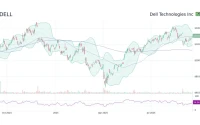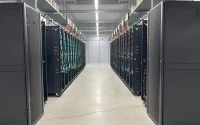The market’s obsession with the AI gold rush has a predictable narrative arc. A dominant chipmaker—in this case, NVIDIA—supplies the shovels, and its stock price (`NVDA`) becomes a proxy for the entire boom. Consequently, any company seen as a primary distributor of these shovels enjoys a commensurate, often dizzying, rise. Super Micro Computer is the current case study, with the `SMCI stock price` charting a course that has left most of the market in its wake.
The surface-level analysis is simple enough. SMCI is fast. It has distinguished itself by being the first to market with integrated systems for the latest generation of AI accelerators, including NVIDIA’s B300 and GB300 platforms. In a land grab, speed is paramount, and SMCI is delivering fully-racked, ready-to-deploy systems while competitors are still circulating spec sheets. This has fueled a remarkable year-to-date gain of 50.4%, a figure that comfortably outpaces the already-hot Zacks Computer- Storage Devices industry average of 36.5%.
But a first-mover advantage in hardware is notoriously fleeting. The giants of the industry, namely Hewlett Packard Enterprise and Dell Technologies, are not idle. HPE has a deep portfolio of high-performance computing solutions, and Dell’s PowerEdge servers are ubiquitous. They will catch up on shipping the latest silicon from `NVDA` and `AMD`. They always do. Relying solely on speed-to-market as a long-term investment thesis is a fragile proposition. It mistakes a good quarter, or even a good year, for a durable competitive moat.
My analysis suggests the real story, the one that might justify a valuation that seems untethered from historical norms, is far less glamorous. It has less to do with the silicon inside the box and more to do with the plumbing connected to it.
The Thermodynamic Moat Wall Street Might Be Missing
The Inescapable Problem of Heat
The computational density required for training and running large AI models generates an extraordinary amount of heat. For every kilowatt of power used for computation, another significant fraction is required just to keep the hardware from melting. This is a problem of physics, and it has a direct and punitive impact on a data center's Total Cost of Ownership (TCO). This is where the narrative shifts from speed to efficiency.
It is projected that over 30% of new global data center deployments in the next twelve months will incorporate liquid cooling. This is not a niche technology for academic supercomputers anymore; it is rapidly becoming the baseline requirement for economically viable AI infrastructure. Super Micro’s strategic focus here appears to be its most defensible asset. The company’s new DLC-2, a direct liquid cooling solution, puts hard numbers on the table: a reduction in power and water consumption by up to 40% and a decrease in the total cost of ownership by a claimed 20%.

These are not trivial figures. For a hyperscaler operating on razor-thin margins, a 20% TCO reduction on its most expensive infrastructure is a tectonic shift in its financial modeling. SMCI is not just selling servers; it is selling a lower electricity bill. It is selling a smaller physical footprint. It is selling a quieter facility (operating at around 50 decibels), which has real implications for where these data centers can be located.
This is coupled with their Data Center Building Block Solutions (DCBBS) architecture. And this is the part of the report that I find genuinely compelling. I've analyzed countless hardware rollouts, and the primary point of failure is rarely the quality of the individual components. It's the integration. The painstaking, time-consuming process of making disparate systems from different vendors work together. SMCI’s modular, pre-integrated approach, combined with its own proprietary and highly efficient cooling, directly attacks this integration friction. They are selling a holistic system, where the cooling is not an afterthought but a core, pre-engineered part of the value proposition.
This brings us to the forward-looking estimates. The Zacks Consensus Estimate projects revenue growth of about 50%—to be more exact, 48%—in 2026. That’s an enormous figure for a company of this scale. But then, the projection drops sharply to 15% in 2027. This deceleration implies that analysts see the current moment as a massive, but temporary, replacement and expansion cycle.
Here, a methodological critique is warranted. It seems plausible that these models are heavily weighted toward the initial hardware sale, the capital expenditure. They may be underestimating the strategic lock-in created by an efficient, integrated ecosystem. When a hyperscaler builds a new facility around a specific cooling and rack architecture (like SMCI’s DLC), the cost and complexity of switching to a different provider for the next hardware refresh become substantial. The TCO benefits are recurring, creating a stickiness that a simple server vendor cannot command. The 15% growth in 2027 might be conservative if the economic benefits of the SMCI ecosystem prove as significant as the initial data suggests. The company is aggressively expanding its manufacturing footprint—a third Silicon Valley campus, plus new or expanded facilities in Taiwan, the Netherlands, and Mexico (a clear nod to near-shoring supply chains)—which indicates they are preparing for sustained, not cyclical, demand.
While the market is transfixed by the performance of `AI stock` tickers from `PLTR` to `SOUN`, the underlying infrastructure race is where the less visible, and perhaps more durable, moats are being built. SMCI’s advantage isn’t just being first with NVIDIA’s chips. It’s about solving the brutal, expensive, second-order problem of thermodynamic reality.
---
The Physics of Profit
The market story is about AI. The stock story is about growth. But the durable business story is about thermodynamics. While everyone is watching the speed of light, chasing the performance of silicon, the long-term winners in this infrastructure war will be the ones who most efficiently manage the movement of heat. Super Micro appears to understand that the laws of physics are a much more reliable competitive advantage than a six-month head start on a product cycle. That is a moat built not on marketing, but on math.
Reference article source:









